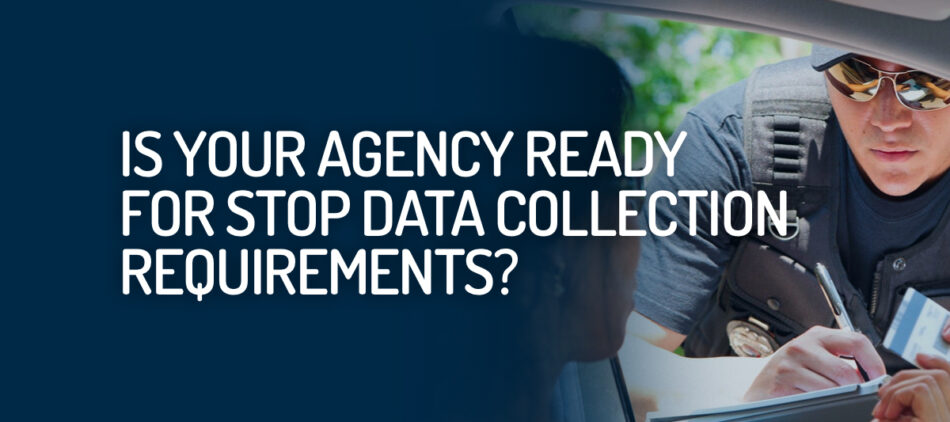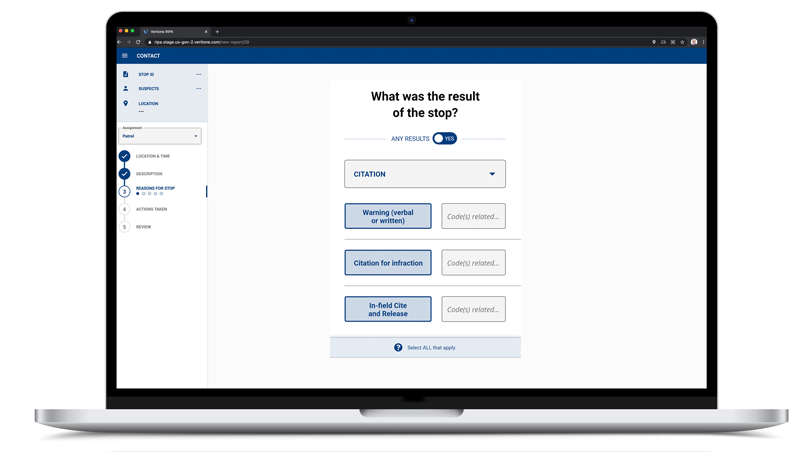
Will stop data collection policies soon be nationwide?
By Jon Gacek, Veritone Head of Government, Legal and Compliance
Traffic and pedestrian stops are routine events for police officers. And soon, complying with data collection policies during and after these stops will also become part of their daily beat.
Stop data collection legislation is rapidly gaining momentum — several states currently have stop policy data collection laws on the books and others are expected to pass similar legislation soon in response to social justice movements and the demand for transparency in policing. But the collection of stop data can be time-consuming and takes officers away from work of public safety. The copious amount of documentation needed to capture this information can also introduce human error if not completed in real-time.
So, how can law enforcement agencies comply with these important legislative initiatives in a way that is both effective and efficient? Automated digital tools may provide the answer.
The push for stop data collection policies is gaining steam
In 1999, North Carolina became the first state in the U.S. to enact a law requiring law enforcement agencies to collect data on all routine traffic stops. States like Illinois, New Jersey and Missouri have followed suit with stop data collection policies of their own.
However, California is leading the push with the enactment of Assembly Bill 953, the Racial and Identity Profiling Act (RIPA). The goal of RIPA is to prevent racial profiling and bias in the already required stop data collection and submission process. AB 953 has the most comprehensive requirements in the nation and requires all local law enforcement agencies in California to collect perceived demographic and other detailed data regarding pedestrian and traffic stops.
Many of the state’s agencies are already obligated to collect and deliver this data. The balance of the agencies have until 2023 to provide this information to the state’s Department of Justice (DOJ) Stop Data Collection System (SDCS). Data collected can include the perceived race or ethnicity, gender and approximate age of the individual stopped, as well as information like the reason for the stop.
| Wave | Agency Count | Officer Count | Start Collection | Start Submission |
| 1 | 6 | 1,000+ | Jul 2018 | Apr 2019 |
| 2 | 4 | 667 – 999 | Jan 2019 | Apr 2020 |
| 3 | 13 | 334 to 666 | Jan 2021 | Apr 2022 |
| 4 | 530 | 1 to 333 | Jan 2022 | Apr 2023 |
California law enforcement agency rollout compliance for the state’s AB953 (RIPA) legislation
At this point, it’s only a matter of time before other states enact similar legislation — and it’s likely to happen sooner rather than later.
The importance of stop data collection
Stop data collection and analysis generates important insights about law enforcement practices and policies. It also uncovers biases and areas for improvement. By gathering information and asking the right questions about agency operations and officer behaviors, law enforcement agencies can improve transparency, and increase public trust and safety.
But even though stop data collection is critical for capturing insights about officer behaviors, it also takes significant time away from other aspects of policing. Instead of spending time on the streets protecting the public, officers must manually fill out forms and gather detailed and subjective information about traffic and pedestrian stops. Some agencies in California have found leveraging tools from their Computer Aided Dispatch (CAD) or Records Management (RMS) vendors can take upwards of five minutes per individual contact in a stop. Twenty minutes of stop data collection for a traffic stop with four or five individuals in the vehicle is not uncommon. Compound this time with the time it also takes records teams to review each report to ensure there is no personally identifiable information (PII) present in the report prior to submission to the state’s Department of Justice, and you can see how time-consuming this might be.
As more states pass stop data collection legislation, it’s important to get compliance right. Stop data and the insights it provides on law enforcement are invaluable for improving community relations. But to assist in data collection and analysis, law enforcement agencies need to evaluate and implement an intelligent, digital solution. With an automated, digital tool, officers can quickly and efficiently record compliant stop data — reducing the time spent on filling out forms and data submission.
Implement an intelligent, digital solution to improve stop data collection
In today’s digital-first world, there are many tools designed to create workflow efficiency for recording and collecting stop data. Don’t waste valuable time trying to tackle stop data collection in-house. Instead, leverage the tools that are already available and designed to get police officers back on patrol faster.
For example, at Veritone, we worked in conjunction with the California DOJ and several city law enforcement agencies within the state to build Veritone Contact, an automated stop data collection solution, and ensure it ethically meets all compliance requirements. Veritone Contact uses automation to expedite data entry and remove PII from any stop data collected.

Digital solutions can streamline your agency’s processes related to stop data collection. Instead of manually filling out forms — which creates opportunities for human error — your law enforcement agency can implement a solution that automates and simplifies the process. Here are a few tips to consider when evaluating solutions.
- Prioritize on-the-go capabilities. Focus on solutions that can be used on any smartphone, desktop or mobile data terminal (MDT), which will help facilitate quick data entry for field interviews and aid in secure storage and transmission. With an easily accessible application, officers can record information on the go, rather than after the fact. This helps reduce errors caused by trying to recall the details of a stop at a later time.
- Reduce errors with intelligent forms. A digital solution can guide officers through the required questions needed to collect observational data. These tools are capable of providing pre-populated “picklist” values for each question, effectively eliminating the time it takes for officers to manually write answers. More importantly, intelligent forms can dynamically adjust required questions to be answered based on prior answers. In an example, if a stop was conducted in a K-12 environment, expose those required questions, otherwise suppress them from the officer’s view to expedite reporting and take the guesswork out of the equation for the officer.
- Pre-screen answers for PII. Tools with AI capabilities can pre-screen answers for potential PII that may have been included in an officer’s response. This is performed similarly to the way spell check works in an email or word processing application. This will significantly save records teams valuable time reviewing reports prior to final submission to your state’s DOJ or other authority.
- Custom data collection. Many agencies are using this opportunity to collect additional information at each stop for additional training or community transparency initiatives. In an example, some agencies want to learn if a traffic stop was conducted on a vehicle with tinted windows as that situation can clearly make observation more difficult. Make sure any solution that provides custom data collection can be configured to only send the required information to your state’s authorities.
- Detailed reporting. Any solution should provide detailed reporting for command staff evaluation and review. You definitely want to be able to review trends prior to your data being made public by your state’s DOJ. Look for solutions that can connect with your agency’s existing reporting tools such as Microsoft PowerBI, Tableau, Alteryx or Domo as well as the ability to export to Microsoft Excel and quick evaluation.
By investing in an intelligent and flexible digital solution, your agency can streamline data submission, increase the accuracy of the data used in criminal justice cases and enable workflow efficiency.
Prepare for new policies now
Soon, stop data collection policies will be enacted across the nation. Your law enforcement agency needs to prepare now by evaluating solutions that fit your needs. An automated solution — like Veritone Contact — can simplify the data entry process and help your agency prepare for compliance with future policies and requirements.
Just as importantly, an automated solution will make it possible for your officers to focus on their most important job: keeping your communities safe.
This article originally appeared in the May 2021 issue of Police Magazine.